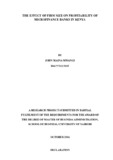| dc.contributor.author | Mwangi, John M | |
| dc.date.accessioned | 2017-01-04T05:18:20Z | |
| dc.date.available | 2017-01-04T05:18:20Z | |
| dc.date.issued | 2016 | |
| dc.identifier.uri | http://hdl.handle.net/11295/98645 | |
| dc.description.abstract | Large banks are complex and diversified; they have different product lines and
integrated services that enable them to be more efficient and to invest in huge
investments that are risky and long-term in nature. Such firms benefit from economies
of scale as compared to smaller firms because their average production costs are less
and while their operational activities are efficient. Descriptive research design was
used to examine the effect of bank size on profitability. The population for this study
involved nine Microfinance banks that were operational during the study period. A
period of five years was (2011-2015) covered and data was obtained from CBK
website. Analysis of data was done with the help of descriptive and inferential
statistics. It was found that bank size, customer deposits, operating efficiency
increased with the study period. Non-performing loans were found to increase posing
credit risks to MFBs. A strong positive correlation was found to exist between
operating efficiency and profitability. In addition, a weak correlation between bank
size and profitability was found to exist. Further, it was found that operating
efficiency and bank size were found to be significant as their probability ratios were
lower than five percent. Customer deposits, asset quality and liquidity were
insignificant as their probability ratios were higher than five percent. Microfinance
banks ought to increase their network of branches countrywide to attract new
customers to open new accounts and in so doing increase their deposits. This will
increase the pool of funds for investment and impact positively on the profitability of
MFBs. Some data from specific variables such as growth in customer deposits were
missing in the year 2010 of the annual statements. This affected the quality of the
sources of data and adequacy to enable the researcher to establish accurate and more
findings on the nexus between bank size and profitability MFBs. A duplication of this
study should be executed in a different industry other than the banking sector such as
the manufacturing firms. This will give room for comparison that might lead future
researchers to a more plausible conclusion so that relevant recommendations can be
reached.
8 | en_US |
| dc.language.iso | en_US | en_US |
| dc.publisher | University of Nairobi | en_US |
| dc.rights | Attribution-NonCommercial-NoDerivs 3.0 United States | * |
| dc.rights.uri | http://creativecommons.org/licenses/by-nc-nd/3.0/us/ | * |
| dc.title | The Effect of Firm Size on Profitability of Microfinance Banks in Kenya | en_US |
| dc.type | Thesis | en_US |



